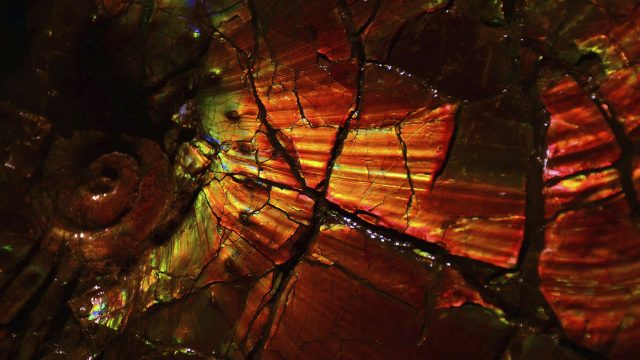Thanks to the paleontologyquestions are still opening about what we know. And this, because fossils are still found that reveal data on the remote past that force settled theories. Despite technological advances, there are still underground surprisesas in the case of a precious stone that was found in an Oklahoma site.
The discovery was starred by a university student. The fossil he found has an iridescent -looking surface and that reveals the presence of a mineral whose existence in that place and time is disconcerting. This type of echo It usually appears in very different geological contexts and with a considerably lower age.
How is the precious stone of 300 million years that should never exist in the United States?
All this stir had its beginning within a Academic Geology Excursion of Rogers State University. The student Kolby Dooling, accompanied by his professor Chris Shelton, identified a fossil fragment with iridescent brightness. It was a copy of ammolitea RARE ORGANIC PRECIOUS STONE which usually appears in the rocky mountains.
The particularity of the discovery does not reside solely in place. The fossil was dated with more than 300 million yearswhich makes it one of the oldest samples ever registered with this gem. Most of the ammolitas known originate in deposits of Cretaceous Superiortherefore, this sample breaks the known temporal schemes.
The characteristic brightness of the ammolite comes from the crystallization of the Aragon, a mineral that forms the ammonites shell. In this case, the Aragon not only filled the fossil, but also covered its exterior, which is not common.
What exactly is the ammolite?
The ammolite It is one of the three gems considered biogenictogether with amber and pearl. Its origin is in the fossilized shells of ammonites, extinct marine animals.
This precious stone It was officially recognized as a gem in 1981 by the World Jewelry Confederation. Since then, its commercial exploitation has been mainly controlled by Korite International, a Canadian company.
Among their alternative names are included Alapo, Calcentina y Corita. Its color does not come from impurities, as in many other gems, but from the microstructure of the Aragon. The interference of light in its multiple layers generates iridescence that covers the entire visible spectrum.
The predominant colors are green and red, although it can also present violet and blue tones.
Next, these are the physical properties of the ammolite:
- Composition: Aragonito, Calcita, silica, pyrite and traces of several elements.
- Hardness: between 4.5 and 5.5 on the Mohs scale.
- Density: 2,6-2,8.
- Refraction index: variable, negative biaxial.
- Fluorescence: You can present yellow tones under ultraviolet light.
Most ammolitas have a thin layer between 0.5 and 0.8 mm and They are usually attached to a schist arrest or limestone. Exposure deterioration results in effects such as “dragon skin,” a visual feature valued in jewelry.
Where does the ammolite extract?
The most relevant deposits of this precious stone are found in the Bearpaw formationa region that covers parts of Alberta, Saskatchewan and Montana, in the United States.
The extraction zones include the Kainah indigenous reserve, whose inhabitants actively participate in mining work and receive financial compensation for the exploitation of their territory.
The extraction process is carried out by open pit mining. The materials are examined manually to separate the ammolite from the sediments. Only about 5% of the extracted material reaches the quality necessary to be used in jewelry.
The best quality ammolite is in deep layers called “blue zone”, more than 45 meters underground. These samples have less fragmentation and a more intense colored game.
How do you think this precious stone came to Oklahoma?
At the moment, the origin of the specimen found in Oklahoma continues to be a study. The scientific community faces the difficulty of explaining how a gem of these characteristics was formed in an environment where similar formations had never been documented.
The most considered hypothesis is that It is an isolated local phenomenonproduct of exceptional conditions of pressure, temperature and sedimentary composition.
However, its temporary dating, much older than usual, raises a question about the evolution and distribution of ammonites in Paleozoic.
As published by the American media ‘Science Alert’researchers have resumed the exploration of the site, where they have already found remains of sharks and other marine invertebrates. Future geochemical analyzes are expected allow to confirm the origin and formation of this precious stone.




